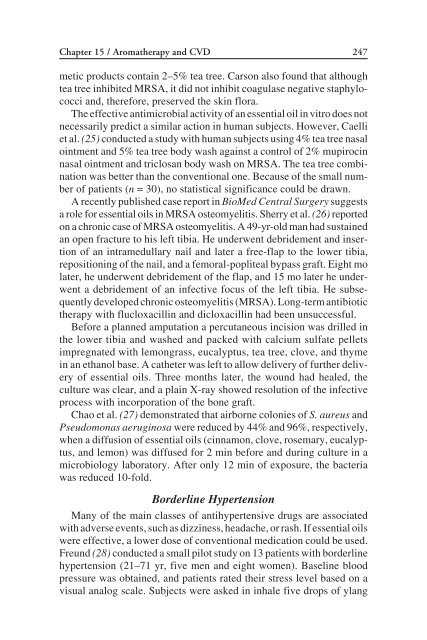Complementary Alternative Cardiovascular Medicine
Complementary Alternative Cardiovascular Medicine
Complementary Alternative Cardiovascular Medicine
You also want an ePaper? Increase the reach of your titles
YUMPU automatically turns print PDFs into web optimized ePapers that Google loves.
Chapter 15 / Aromatherapy and CVD 247<br />
metic products contain 2–5% tea tree. Carson also found that although<br />
tea tree inhibited MRSA, it did not inhibit coagulase negative staphylococci<br />
and, therefore, preserved the skin flora.<br />
The effective antimicrobial activity of an essential oil in vitro does not<br />
necessarily predict a similar action in human subjects. However, Caelli<br />
et al. (25) conducted a study with human subjects using 4% tea tree nasal<br />
ointment and 5% tea tree body wash against a control of 2% mupirocin<br />
nasal ointment and triclosan body wash on MRSA. The tea tree combination<br />
was better than the conventional one. Because of the small number<br />
of patients (n = 30), no statistical significance could be drawn.<br />
A recently published case report in BioMed Central Surgery suggests<br />
a role for essential oils in MRSA osteomyelitis. Sherry et al. (26) reported<br />
on a chronic case of MRSA osteomyelitis. A 49-yr-old man had sustained<br />
an open fracture to his left tibia. He underwent debridement and insertion<br />
of an intramedullary nail and later a free-flap to the lower tibia,<br />
repositioning of the nail, and a femoral-popliteal bypass graft. Eight mo<br />
later, he underwent debridement of the flap, and 15 mo later he underwent<br />
a debridement of an infective focus of the left tibia. He subsequently<br />
developed chronic osteomyelitis (MRSA). Long-term antibiotic<br />
therapy with flucloxacillin and dicloxacillin had been unsuccessful.<br />
Before a planned amputation a percutaneous incision was drilled in<br />
the lower tibia and washed and packed with calcium sulfate pellets<br />
impregnated with lemongrass, eucalyptus, tea tree, clove, and thyme<br />
in an ethanol base. A catheter was left to allow delivery of further delivery<br />
of essential oils. Three months later, the wound had healed, the<br />
culture was clear, and a plain X-ray showed resolution of the infective<br />
process with incorporation of the bone graft.<br />
Chao et al. (27) demonstrated that airborne colonies of S. aureus and<br />
Pseudomonas aeruginosa were reduced by 44% and 96%, respectively,<br />
when a diffusion of essential oils (cinnamon, clove, rosemary, eucalyptus,<br />
and lemon) was diffused for 2 min before and during culture in a<br />
microbiology laboratory. After only 12 min of exposure, the bacteria<br />
was reduced 10-fold.<br />
Borderline Hypertension<br />
Many of the main classes of antihypertensive drugs are associated<br />
with adverse events, such as dizziness, headache, or rash. If essential oils<br />
were effective, a lower dose of conventional medication could be used.<br />
Freund (28) conducted a small pilot study on 13 patients with borderline<br />
hypertension (21–71 yr, five men and eight women). Baseline blood<br />
pressure was obtained, and patients rated their stress level based on a<br />
visual analog scale. Subjects were asked in inhale five drops of ylang


